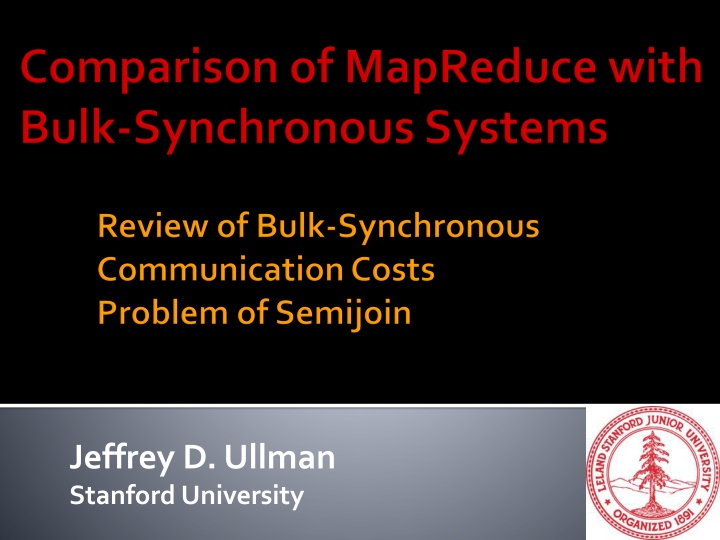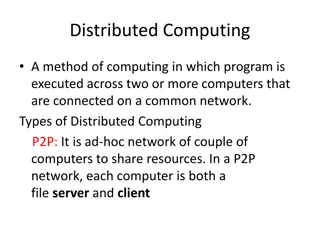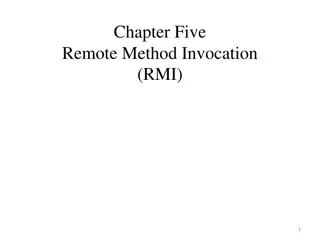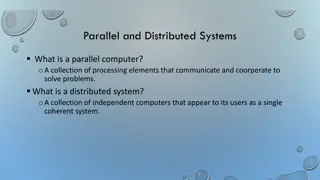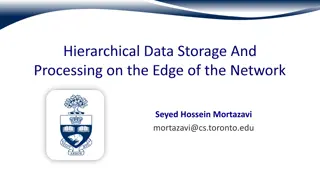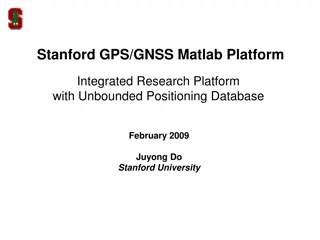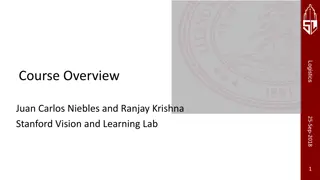Introduction to Distributed Computing at Stanford University
A meeting at Stanford University's Gates building tonight for those interested in CS341 in the Spring. The session will cover the concept of viewing computation as a recursion on a graph, techniques like Pregel, Giraph, GraphX, and GraphLab for distributed computing, and challenges in data movement within systems like MapReduce. Join for insights on optimizing tasks, handling high-degree nodes, and more.
Download Presentation

Please find below an Image/Link to download the presentation.
The content on the website is provided AS IS for your information and personal use only. It may not be sold, licensed, or shared on other websites without obtaining consent from the author.If you encounter any issues during the download, it is possible that the publisher has removed the file from their server.
You are allowed to download the files provided on this website for personal or commercial use, subject to the condition that they are used lawfully. All files are the property of their respective owners.
The content on the website is provided AS IS for your information and personal use only. It may not be sold, licensed, or shared on other websites without obtaining consent from the author.
E N D
Presentation Transcript
Jeffrey D. Ullman Stanford University
We meet 6PM tonight in 415 Gates. Useful if you are planning to take CS341 in the Spring. Everyone welcome, no commitment expected. Slides will be posted, initially at i.stanford.edu/~ullman/cs341slides.html No need to sign up; pizza is already ordered. 3
Views all computation as a recursion on some graph. Graph nodes send messages to one another. Messages bunched into supersteps, where each graph node processes all data received. Sending individual messages would result in far too much overhead. Checkpoint all compute nodes after some fixed number of supersteps. On failure, rolls all tasks back to previous checkpoint. 4
Is this the shortest path from M I know about? If so I found a path from node M to you of length L I found a path from node M to you of length L+6 table of shortest paths to N Node N I found a path from node M to you of length L+5 5 6 3 I found a path from node M to you of length L+3 5
Pregel: the original, from Google. Giraph: open-source (Apache) Pregel. Built on Hadoop. GraphX: a similar front end for Spark. GraphLab: similar system that deals more effectively with nodes of high degree. Will split the work for such a graph node among several compute nodes. 6
All these systems move data between tasks. It is rare that (say) a Map task feeds a Reduce task at the same compute node. And even so, you probably need to do disk I/O. Gigabit communication seems like a lot, but it is often the bottleneck. 7
There is a subtle difference regarding how one avoids moving big data in MapReduce and Bulk- Synchronous systems. Example: join of R(A,B) and S(B,C), where: A is a really large field a video. B is the video ID. S(B,C) is a small number of streaming requests, where C is the destination. If we join R and S, most R-tuples move to the reducer for the B-value needlessly. 8
Might want to semijoin first: find all the values of B in S, and filter those (a,b) in R that are dangling (will not join with anything in S). Then Map need not move dangling tuples to any reducer. But the obvious approach to semijoin also requires that every R-tuple be sent by its mapper to some reducer. 9
To semijoin R(A,B) with S(B,C), use B as the key for both relations. From R(a,b) create key-value pair (b, (R,a)). From S(b,c) create key-value pair (b,S). Almost like join, but you don t need the C-value. 10
Recent implementations of MapReduce allow distribution of small amounts of data to every compute node. Project S onto B to form set S and distribute S everywhere. Then, run the standard MapReduce join, but have the Map function check that (a,b) has b in S before emitting it as a key-value pair. If most tuples in R are dangling, it saves substantial communication. 11
Table with all B-values from S Is b there? R(a,b) Mapper 12
Table with all B-values from S Yes R(a,b) (b, (R,a)) Mapper 13
Table with all B-values from S No R(a,b) (nothing) Mapper 14
Create a graph node for every tuple, and also for every B-value. All tuples (b,c) from S send a message to the node for B-value b. All tuples (a,b) from R send a message with their node name to the node for B-value b. The node for b sends messages to all (a,b) in R, provided it has received at least one message from a tuple in S. Now, we can mimic the MapReduce join without considering dangling tuples. 15
Node for R(a1,b1) Node for R(a2,b2) I exist I exist Node for b1 Node for b2 b1 OK b1 OK Node for S(b1,c1) Node for S(b1,c2) 16
Node for R(a1,b1) Node for R(a2,b2) You are needed Node for b1 OK Node for b2 Node for S(b1,c1) Node for S(b1,c2) 17
Node for R(a1,b1) Node for R(a2,b2) (b1, (R,a1)) Node for b1 OK Node for b2 (b1, (S,c1)) (b1, (S,c2)) Node for S(b1,c1) Node for S(b1,c2) 18
